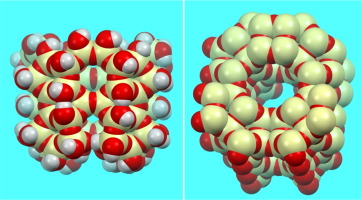Computational and Theoretical Chemistry ( IF 3.0 ) Pub Date : 2019-08-30 , DOI: 10.1016/j.comptc.2019.112572 Alexander V. Vorontsov , Héctor Valdés , Panagiotis G. Smirniotis

|
Zeolites are widely used for numerous processes for production of a vast number of chemicals, fuels and commercial goods. Preparation of zeolite catalysts that have improved selectivity for the desired products, operate at lower temperature and possess increased stability is therefore of great interest. The key to such improved zeolite catalysts is in the design of active sites and facilitation of mass transfer via optimization of the porous structure. At the same time, undesirable sites that inhibit desirable properties of the active sites need to be removed or blocked. The strength and structure of either the Brønsted or Lewis acid sites, directly determines their catalytic activity and selectivity for each reaction. In the present study, the structure and acidity of active sites in zeolites are investigated for the example of mordenite using modern semiempirical methods pm7 and scc-dftb (dftb2). Models AlHSi95O192 and Al2H2Si94O192 are used for Brønsted acid sites and Al2Si94O191 for Lewis acid sites. In agreement with previous studies, the stability of T1, T2, T3 and T4 sites is similar. Many different configurations of pair-wise located Al atoms were studied. In the present work it was found that some of the pair-wise located Al atoms possess Brønsted acid sites with strength much higher than that for single Brønsted acid sites. However, since their stability is not the highest among other double sites, special preparation methods need to be developed for selectively obtaining these very active sites. The stability of different Lewis acid sites is also considered.
中文翻译:

使用现代半经验方法设计沸石催化剂中的活性位点:丝光沸石
沸石被广泛用于生产大量化学品,燃料和商业产品的众多过程中。因此,对具有对所需产物具有改进的选择性,在较低温度下操作并具有增加的稳定性的沸石催化剂的制备非常感兴趣。这种改进的沸石催化剂的关键在于活性位点的设计和通过优化多孔结构来促进传质。同时,需要去除或阻断抑制活性位点的期望性质的不期望位点。布朗斯台德或路易斯酸位的强度和结构直接决定了它们在每个反应中的催化活性和选择性。在目前的研究中,例如,使用现代半经验方法pm7和scc-dftb(dftb2),以丝光沸石为例,研究了沸石中活性部位的结构和酸度。型号AlHSi布朗斯台德酸性部位使用95 O 192和Al 2 H 2 Si 94 O 192,而Al 2 Si 94 O 191使用Al 2 H 94 Si 191路易斯酸位点。与先前的研究一致,T1,T2,T3和T4位点的稳定性相似。研究了成对定位的Al原子的许多不同构型。在目前的工作中,发现一些成对布置的Al原子具有布朗斯台德酸位点,其强度远高于单个布朗斯台德酸位点的强度。但是,由于它们的稳定性在其他双位点中并不是最高的,因此需要开发特殊的制备方法以选择性地获得这些非常活跃的位点。还考虑了不同路易斯酸位点的稳定性。











































 京公网安备 11010802027423号
京公网安备 11010802027423号